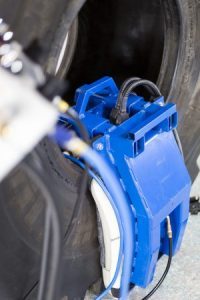Sidewall repairs are a crucial part of any OTR tyre maintenance programme. The 4th in our series of articles looks at the role of sidewall repairs in maximising the lifespan of OTR tyres and minimising time lost due to unforeseen issues and failures.
The sidewall is a vital component of the tyre’s construction providing protection to the casing and absorbing the impact from movement and the terrain.
Physical sidewall injuries can be especially common in rocky environments with cuts from sharp outcrops of rocks and loose rocky material left on the haul roads.
Following these top tips will help maximise the efficacy of your tyre repair operation and the life span of your tyres:
1. Training in Sidewall repairs in key
The art of OTR tyre repair requires technicians to make multiple judgments about the viability of a repair scenario. Robust processes and regular training in both repair practices and the systems in use are absolutely a key to ensuring best practice is adhered to. Look for suppliers, such as Monaflex, who offer ongoing training and support.
2. Always adhere to your patch manufacture guidelines
Refer to the charts and consider the entire patch product range. Some manufactures offer different products for specific applications; choose the product that is best suited to the job at hand.
3. Factor in the tyre’s service context
Ensure you understand how the tyre will be used when back in service. Tyres used, for example, in severe service applications may need to be treated in a special way.
4. Get the basics right
For a successful heat cure double check you have the right pressure, temperature and establish the correct cure time.
5. Always check the non-repairable area first
When measuring a sidewall injury, check the non-repairable area first otherwise you risk wasting time on the rest of the inspection if the damage is located here.
6. Watch out for the second sidewall ply in many Radial OTR tyres
Note that this second ply is a ply and not a carcass cord. It is present through about half of the sidewall from the bead toe on the outside of the tyre. This ply turn will need special treatment (depending on the nature of the sidewall damage).
7. Don’t over fill the skive
Repair technicians typically overbuild the filler rubber when using spotter style vulcanizing equipment to compensate for rubber running away from the distorted repair area. This is particularly common in sidewall repairs.
However this wastes curing and buffing time, and the costly filler rubber and can also increase tyre distortion. With a Monaflex system you don’t need this excessive overbuild. The flexible components conform completely to the shape of the tyre and during the cure the filler rubber is totally encased by the Airbag eliminating the rubber migration and leaving a feather edged finish.
8. Correct tyre maintenance can prevent unnecessary injuries

Correct inflation of the tyres and preventing overloading is the primary way to avoid early onset sidewall damage. Operating conditions including geology, temperature and weather will all effect the correct inflation of the tyres and care should be taken to follow the manufacturer’s recommendations at all times.
If the pressure is too low for example, you may increased flexing in the tyre causing excessive wear and heating, and an increase in fuel consumption.
The Monaflex OTR Customer system covers repairs to the Sidewall, Shoulder and Crown/Tread. If you are experiencing a high volume of sidewall injuries you will find the OTRS and XLOTRS offer convenient specialist repair solutions. For more information, please get in touch.
